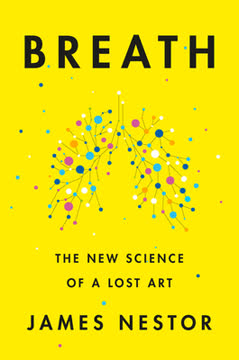Key Takeaways
1. Posture is dynamic: Adapt to daily demands, not a rigid ideal
Posture is a very complex interplay between the neurological and musculoskeletal systems within the body, which all come together to make up a specific position.
Posture is not static. It's a constantly evolving response to the demands we place on our bodies. Factors influencing posture include:
- Habits: Daily routines and repetitive movements
- Neurological reflexes: Automatic responses to maintain balance
- Physical adaptations: Body's adjustments to minimize energy expenditure
- Time: Cumulative effects of lifestyle choices
Rather than striving for a single "perfect" posture, focus on developing the ability to move efficiently and comfortably through various positions. This adaptability is key to maintaining good alignment in diverse situations, from sitting at a desk to engaging in physical activities.
2. Good alignment boosts confidence, performance, and overall well-being
Evidence from various studies shows that improved posture can make you more powerful and more confident.
Posture affects psychology. Good alignment has far-reaching benefits beyond physical appearance:
- Increased confidence and self-perception
- Improved test-taking and interview performance
- Boosted testosterone levels
- Enhanced pain tolerance
- Better cognitive function in older adults
Physically, good posture:
- Facilitates efficient breathing
- Improves athletic performance
- May decrease injury risk
By working on your posture, you're not just changing how you look, but potentially enhancing multiple aspects of your life and health.
3. Pain and posture: Complex relationship beyond simple cause-effect
Generally speaking, pain is a protective mechanism, not necessarily a symptom of damage.
Pain is multifaceted. The relationship between posture and pain is more complex than commonly believed. Key points to understand:
- Posture alone doesn't necessarily cause or indicate pain
- Pain is influenced by biological, psychological, and social factors
- The body's pain response can become oversensitive, leading to discomfort in normal positions
Factors contributing to pain:
- Muscle weakness and lack of endurance
- Stress and anxiety
- Sleep quality
- Social and emotional context
Understanding pain's complexity helps in developing more effective strategies for managing discomfort and improving posture. Focus on building strength, endurance, and overall body awareness rather than fixating solely on achieving a specific postural position.
4. Corrective exercises: Target mobility, stability, strength, and endurance
The goal is to become comfortable with multiple planes of motion.
Exercise for versatility. Effective postural improvement involves a comprehensive approach:
- Mobility exercises: Improve range of motion and flexibility
- Examples: Chin tucks, spinal circles, hip flexor stretches
- Stability exercises: Enhance control and balance
- Examples: Planks, bird dogs, single-leg stands
- Strength exercises: Build muscle to support proper alignment
- Examples: Rows, squats, deadlifts
- Endurance exercises: Increase stamina for maintaining good posture
- Examples: Wall sits, farmer's walks, prone holds
Incorporate exercises that challenge your body in multiple planes of motion to develop well-rounded postural control. This approach helps your body adapt to various positions and movements encountered in daily life, rather than being limited to a single "correct" posture.
5. Mindfulness and sustained habits: Key to long-term postural improvement
Mindfulness and sustained habits that aid this process are key.
Awareness drives change. Improving posture is not just about physical exercises; it requires a shift in daily habits and increased body awareness:
-
Develop postural mindfulness:
- Set reminders to check your posture throughout the day
- Practice body scans to identify areas of tension or misalignment
- Use environmental cues (e.g., walking through a doorway) as triggers to reset your posture
-
Create sustainable habits:
- Start with small, achievable goals to build consistency
- Integrate postural exercises into existing routines (e.g., during work breaks)
- Use habit-stacking techniques to link postural practices with established habits
-
Regular self-assessment:
- Periodically evaluate your progress and adjust your approach as needed
- Celebrate small improvements to maintain motivation
By combining physical exercises with increased awareness and consistent habits, you create a holistic approach to postural improvement that is more likely to yield long-lasting results.
6. Neuroplasticity: Your nervous system can change with practice
Just knowing this can be profound. Habit change requires breaking associations and replacing past perceptions with new realities.
Your brain adapts. Neuroplasticity is the brain's ability to form new neural connections and adapt throughout life. This concept is crucial for postural improvement:
- Challenges the belief that posture is fixed or unchangeable
- Encourages persistence in the face of initial discomfort or difficulty
- Supports the idea that consistent practice leads to lasting change
Applying neuroplasticity to posture:
- Repetition: Consistently practice good alignment to reinforce new neural pathways
- Variety: Engage in diverse movements and exercises to promote adaptability
- Attention: Focus on body sensations and alignment during daily activities
- Gradual progression: Incrementally challenge yourself to solidify improvements
Understanding neuroplasticity can boost motivation and reinforce the importance of consistent practice in achieving postural goals.
7. Consistency trumps perfection in postural correction
Avoid the trap of perfectionism in every facet of your postural correction plan.
Sustainable progress matters. When working on posture, it's crucial to prioritize consistency over perfection:
- Start small: Begin with a manageable routine you can stick to
- Build gradually: Slowly increase the complexity and duration of your exercises
- Be patient: Recognize that postural change takes time and sustained effort
Avoid common pitfalls:
- Overly ambitious plans that lead to burnout
- Excessive self-criticism for not achieving "perfect" posture
- Neglecting other aspects of health and fitness in pursuit of ideal alignment
Focus on making posture improvement a regular, integrated part of your lifestyle rather than an all-or-nothing endeavor. This approach leads to more sustainable, long-term results.
8. Tailor your approach: Individualize exercises and strategies
If you notice your routine is not working, vary it to figure out what works best for you!
Personalization is key. There's no one-size-fits-all solution for postural improvement. Factors to consider when customizing your approach:
- Individual anatomy and physiology
- Lifestyle and occupation
- Existing health conditions or injuries
- Personal goals and preferences
Strategies for tailoring your program:
- Experiment with different exercises and find what feels most effective
- Adjust frequency and intensity based on your schedule and recovery needs
- Combine various techniques (e.g., stretching, strength training, mindfulness)
- Seek professional guidance for personalized recommendations
Regularly assess your progress and be willing to modify your approach. What works well initially may need adjustment as you improve or encounter new challenges.
9. Program design: Structure workouts for optimal results
There is a method to the madness of ordering exercises in your workout.
Sequencing matters. Properly structuring your postural improvement routine enhances effectiveness:
- Soft tissue work / Heat: Loosens tight muscles, improves blood flow
- Light stretching, mobility, and stability work: Prepares body for movement
- Strength and endurance exercises: Builds supportive musculature
- Mobility / Stability work: Solidifies gains and improves body awareness
Additional programming considerations:
- Balance different types of exercises (mobility, stability, strength, endurance)
- Progressively increase difficulty as you improve
- Allow adequate rest and recovery between sessions
- Integrate postural work with other fitness goals
By thoughtfully designing your program, you maximize the benefits of each exercise and create a more cohesive, effective approach to postural improvement.
10. Posture as a lifelong journey: Embrace the process of improvement
Find what will keep you going for the next year or more and you'll be amazed at the changes that you will see take place in your life.
Long-term perspective. Improving posture is not a quick fix but a continuous process of self-improvement:
- Set realistic expectations for the time and effort required
- Celebrate small victories and incremental progress
- View setbacks as learning opportunities, not failures
- Regularly reassess and adjust your goals and methods
Benefits of a lifelong approach:
- Sustainable improvements in posture and overall health
- Increased body awareness and movement efficiency
- Development of valuable self-discipline and consistency
- Potential for ongoing personal growth and self-discovery
By embracing posture improvement as a lifelong journey, you shift focus from achieving a perfect end state to enjoying the ongoing benefits of better alignment and body awareness. This mindset promotes consistency and helps integrate postural work into your broader health and wellness goals.
Last updated:
FAQ
1. What is "Overcoming Poor Posture" by Steven Low about?
- Comprehensive Posture Guide: The book provides a systematic approach to understanding, assessing, and improving posture for better health and performance.
- Myth-Busting: It dispels common myths about posture, emphasizing that posture is not just a static position but a dynamic interplay of habits, neurological reflexes, and physical adaptations.
- Practical Solutions: The authors offer corrective exercises, habit-building strategies, and mindset shifts to help readers make lasting changes.
- Evidence-Based Approach: The book is grounded in current research, integrating insights from physical therapy, pain science, and movement disciplines.
2. Why should I read "Overcoming Poor Posture" by Steven Low?
- Holistic Understanding: It goes beyond superficial advice, helping readers understand the true mechanisms behind posture and its impact on health and performance.
- Actionable Strategies: The book provides clear, practical steps and sample routines that can be tailored to individual needs and schedules.
- Addresses Pain and Performance: It explains the relationship between posture, pain, and physical capability, offering solutions for both prevention and rehabilitation.
- Sustainable Change: Emphasis is placed on habit formation and mindset, ensuring that improvements are maintained over the long term.
3. What are the key takeaways from "Overcoming Poor Posture" by Steven Low?
- Posture is Dynamic: Posture results from a complex interaction of habits, neurological reflexes, physical adaptations, and time—not just bone alignment.
- No Universal "Perfect" Posture: There is no single ideal posture; optimal alignment is individual and task-specific.
- Strength and Endurance Matter: Improving muscle strength and endurance, rather than just changing posture, is key to reducing pain and enhancing function.
- Habit and Mindset are Crucial: Sustainable improvement comes from consistent habit change and a growth-oriented mindset.
4. How does "Overcoming Poor Posture" by Steven Low define posture and alignment?
- Posture Definition: Posture is described as the result of the interplay between the neurological and musculoskeletal systems, influenced by habits, reflexes, adaptations, and time.
- Alignment Explained: Alignment refers to the relative positioning of joints for optimal movement and function, rather than a rigid, static position.
- Movement Context: The book reframes posture as the ability to move well from various alignments, emphasizing adaptability over rigidity.
- Technique Over Ideal: Proper technique for specific tasks is prioritized over striving for a universal "good posture."
5. What are the main myths about posture addressed in "Overcoming Poor Posture" by Steven Low?
- Myth of One Perfect Posture: The book debunks the idea that there is a single, universally optimal posture for everyone.
- Posture and Pain: It challenges the belief that poor posture directly causes pain, citing research that shows no consistent link between posture and pain.
- Structural Blame: The authors refute the notion that structural factors like pelvic tilt or spinal curves are primary causes of back pain.
- Quick Fixes: The book warns against relying solely on devices, rigid routines, or isolated stretches as solutions.
6. How does "Overcoming Poor Posture" by Steven Low connect posture, pain, and performance?
- Complex Pain Science: The book explains pain using modern models (biopsychosocial and neuromatrix), showing that pain is influenced by biological, psychological, and social factors.
- Muscle Endurance Over Structure: Research cited in the book shows that muscle weakness and poor endurance, not posture itself, are more closely linked to pain.
- Performance Benefits: Improved alignment and movement quality can enhance breathing, energy efficiency, and athletic performance.
- Desensitization and Rehabilitation: Postural work can help desensitize protective mechanisms in the body, aiding recovery and reducing chronic pain.
7. What practical steps and exercises does "Overcoming Poor Posture" by Steven Low recommend for improving posture?
- Corrective Exercises: The book provides detailed instructions for mobility, stability, strength, and endurance exercises targeting common postural issues.
- Sample Routines: It offers sample plans for different needs (bare minimum, work breaks, neck/back focus, lower body emphasis, etc.).
- Habit Integration: Readers are encouraged to incorporate exercises into daily routines and to start with manageable amounts for consistency.
- Progression and Personalization: Exercises are presented with progressions and variations to suit individual abilities and goals.
8. What are Upper Crossed Syndrome (UCS) and Lower Crossed Syndrome (LCS) according to "Overcoming Poor Posture" by Steven Low?
- Definitions: UCS involves head-forward posture with weak neck flexors and scapular retractors, and tight upper cervical and chest muscles; LCS involves anterior pelvic tilt with weak glutes and abs, and tight hip flexors and back.
- Modern Perspective: The book explains that these syndromes are not strict diagnoses but useful heuristics for common patterns seen in sedentary lifestyles.
- Underlying Causes: Rather than muscle tightness or weakness alone, these patterns result from accumulated habits, adaptations, and lack of movement.
- Correction Focus: Addressing these patterns requires strengthening, mobility work, and especially habit change, not just stretching or isolated exercises.
9. How does "Overcoming Poor Posture" by Steven Low address habit change and motivation for lasting improvement?
- Consistency Over Perfection: The book emphasizes starting small and being consistent, rather than aiming for perfect routines that lead to burnout.
- Intrinsic and Extrinsic Motivation: It discusses the importance of understanding personal motivation—whether enjoyment of the process or working toward rewards.
- Neuroplasticity: The concept that the nervous system can change with practice is highlighted, reinforcing the possibility of lasting habit change.
- Self-Assessment: Regular checkpoints and honest self-reflection are recommended to adapt plans and maintain progress.
10. What is the recommended approach to programming and structuring a posture improvement routine in "Overcoming Poor Posture" by Steven Low?
- Purposeful Exercise Selection: Each exercise should have a clear purpose—improving range of motion, strength, or body awareness.
- Order of Exercises: The suggested order is: soft tissue work/heat, light stretching/mobility/stability, strength/endurance, then more mobility/stability.
- Frequency and Intensity: Daily mobility and regular flexibility work are recommended, with adjustments based on individual response and goals.
- Trial and Error: The book encourages experimentation to find the optimal frequency, intensity, and exercise selection for each person.
11. What are some of the most effective corrective exercises featured in "Overcoming Poor Posture" by Steven Low?
- Chin Tucks and Variations: For addressing head-forward posture and strengthening neck flexors.
- Thoracic Extension and Cat/Camel: To improve spinal mobility and counteract slumping.
- Hip Flexor Stretch and Glute Activation: To address lower crossed patterns and improve pelvic alignment.
- Segmental Rolling and Resets: For enhancing body awareness, coordination, and reducing tension.
- Foot Drills and Squats: To restore lower body mobility and proprioception, especially for those with sedentary habits.
12. What are the best quotes from "Overcoming Poor Posture" by Steven Low and what do they mean?
- "Perfect is the enemy of the good." – Emphasizes the importance of consistent, manageable effort over striving for unattainable perfection.
- "We are what we practice, and over time, we can change what was once thought to be static and unchangeable." – Highlights the power of neuroplasticity and habit in transforming posture and movement.
- "People totally overestimate what they can do in a month or three months, but they totally underestimate what they can do in a year." – Encourages a long-term perspective for meaningful, sustainable change.
- "The definition of insanity is doing the same thing repeatedly and expecting a different result." – Reminds readers to reassess and adapt their strategies if progress stalls, rather than persisting with ineffective methods.
Review Summary
Overcoming Poor Posture receives mixed reviews, with an average rating of 3.94/5. Readers appreciate its practical advice, helpful exercises, and concise approach to posture improvement. Many find the routines and information valuable, especially for those with prior knowledge in physical therapy. However, some criticize the book's organization, technical language, and lack of detailed planning. Several reviewers note the book's emphasis on individual alignment rather than a one-size-fits-all approach. Despite its shortcomings, many readers find it a useful resource for improving posture and body awareness.
Similar Books










Download PDF
Download EPUB
.epub digital book format is ideal for reading ebooks on phones, tablets, and e-readers.





